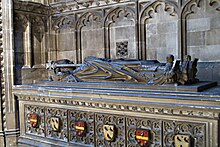William Warham
William Warham | |
|---|---|
| Archbishop of Canterbury | |
 Portrait byHans Holbein the Younger(1527) | |
| Church | Catholic Church |
| Appointed | 29 November 1503 |
| Term ended | 22 August 1532 |
| Predecessor | Henry Deane |
| Successor | Thomas Cranmer |
| Orders | |
| Consecration | 25 September 1502 byRichard Foxe |
| Personal details | |
| Born | c. 1450 |
| Died | 22 August 1532 Hackington, Kent, England |
| Buried | Canterbury Cathedral,Kent |
| Signature | |
William Warham(c. 1450– 22 August 1532) was theArchbishop of Canterburyfrom 1503 to his death in 1532.
Early life and education[edit]
Warham was the son of Robert Warham ofMalshangerinHampshire.He was educated atWinchester CollegeandNew College, Oxford.[1]
Legal career[edit]
After graduating, Warham practised and taught law both in London andOxford.[2]His father was a tenant farmer,[3]but his brother, Sir Hugh Warham, acquired an estate atCroydon,which passed to his daughter Agnes, who married SirAnthony St Leger.[4]
Bishopric[edit]
Later, Warham took holy orders, held two livings (Barley and Cottenham) and becameMaster of the Rollsin 1494.Henry VIIfound him a useful and clever diplomatist. He helped to arrange the marriage between Henry's son,Arthur, Prince of Wales,andCatherine of Aragon.He went to Scotland withRichard Foxe,then bishop of Durham, in 1497. He was partly responsible for several commercial and other treaties withMaximilian I, Holy Roman Emperor,alsoCount of FlandersandRegentDuke of Burgundy,on behalf of his sonPhilip IV of Burgundy.
Archbishopric[edit]
In 1502, he was consecratedBishop of Londonand became Keeper of the Great Seal, but his tenure of both offices was short, as in 1504, he becameLord Chancellorand Archbishop of Canterbury. In 1506, he became Chancellor ofOxford University,a role he held until his death. In 1509, he presided over the wedding of and then crownedHenry VIIIand Catherine of Aragon.

On 28 September 1511, he made a visit to the hospital atMaison Dieu, Faversham.[5]
As archbishop, Warham seems to have been somewhat arbitrary; for example, his actions led to a serious quarrel with Foxe, thenBishop of Winchester,and others in 1512. That made him gradually withdraw into the background after the coronation. He resigned the office of Lord Chancellor in 1515 and was succeeded byThomas Wolsey,whom he had consecrated asbishop of Lincolnin the previous year. His resignation was possibly because of his dislike of Henry's foreign policy.
Warham was present at theField of the Cloth of Goldin 1520 and assisted Wolsey as assessor during the secret inquiry into the validity of Henry's marriage with Catherine in 1527. Throughout the divorce proceedings, Warham's position was essentially that of an old and weary man. He was named as one of the counsellors to assist the queen, but, fearing to incur the king's displeasure and using his favourite phraseira principis mors est( "the king's anger is death" ), he gave her very little help and signed the letter toPope Clement VIIthat urged the pope to assent to Henry's wish. Later, it was proposed that the archbishop himself should try the case, but the suggestion came to nothing.
Warham presided over the Convocation of 1531, when the clergy of the Province of Canterbury voted £100,000 to the king to avoid the penalties ofpraemunireand accepted Henry as supreme head of the church with the face-saving clause "so far as theLaw of Christallows ".
In Warham's concluding years, however, the archbishop showed rather more independence. In February 1532, he protested against all acts concerning the church passed by the parliament that met in 1529, but that did not prevent the important proceedings which secured the complete submission of the church to the state later in the same year. Against this further compliance with Henry's wishes, Warham drew up a protest in which he likened the action of Henry VIII to that ofHenry IIand urgedMagna Cartain defence of the liberties of the church.[6]He attempted in vain to strike a compromise during theSubmission of the Clergy.
Death and legacy[edit]
Having been munificent in his public and moderate in his private life, he died on a visit to his nephew, alsoWilliam Warham.He was buried in the Martyrdom (north) transept ofCanterbury Cathedral.He was succeeded as archbishop by his rival, Thomas Cranmer.[7]Warham Guildwas named after him.
References[edit]
- ^Waad-Warwright Pages 1550-1577 Alumni Oxonienses 1500-1714
- ^Lee, Sidney,ed. (1899)..Dictionary of National Biography.Vol. 59. London: Smith, Elder & Co. p. 384.
- ^Gwyn, PeterThe King's Cardinal- the rise and fall of Thomas Wolsey1990 Pimlico Edition p.26
- ^Lee, Sidney,ed. (1897)..Dictionary of National Biography.Vol. 50. London: Smith, Elder & Co. p. 167.
- ^Hasted, Edward (1798)."Parishes".Hospitals: Ospringe, A History of the County of Kent.2.Institute of Historical Research: 222–224.Retrieved14 March2014.
- ^Chisholm, Hugh,ed. (1911)..Encyclopædia Britannica.Vol. 28 (11th ed.). Cambridge University Press. p. 325.
- ^Stephen Taylor (1999).From Cranmer to Davidson: A Church of England Miscellany.Boydell & Brewer. pp. 11–.ISBN978-0-85115-742-9.
Sources[edit]
- John Sherren Brewer,Reign of Henry VIII(1884)
- James Gairdner,Lee, Sidney,ed. (1899)..Dictionary of National Biography.Vol. 58. London: Smith, Elder & Co.
- James Gairdner,The English Church in the 16th Century(1902)
- W. F. Hook,Lives of the Archbishops of Canterbury(1860?1876)
- A. F. Pollard,Henry VIII(1905)
- This article incorporates text from a publication now in thepublic domain:Chisholm, Hugh,ed. (1911). "Warham, William".Encyclopædia Britannica.Vol. 28 (11th ed.). Cambridge University Press. p. 325.
- Burton, Edwin Hubert (1912)..In Herbermann, Charles (ed.).Catholic Encyclopedia.Vol. 15. New York: Robert Appleton Company.
- Scarisbrick, J. J. "Warham, William (1450?–1532)".Oxford Dictionary of National Biography(online ed.). Oxford University Press.doi:10.1093/ref:odnb/28741.(Subscription orUK public library membershiprequired.)
- https:// sanfransentinel /etislearyllatotcom.html}
External links[edit]
- Lord Chancellors
- 1450s births
- 1532 deaths
- Lord chancellors of England
- Archbishops of Canterbury
- Bishops of London
- 16th-century English Roman Catholic archbishops
- Alumni of New College, Oxford
- People from Oakley, Hampshire
- Chancellors of the University of Oxford
- Masters of the Rolls
- People educated at Winchester College
- 15th-century English Roman Catholic priests
- Burials at Canterbury Cathedral
